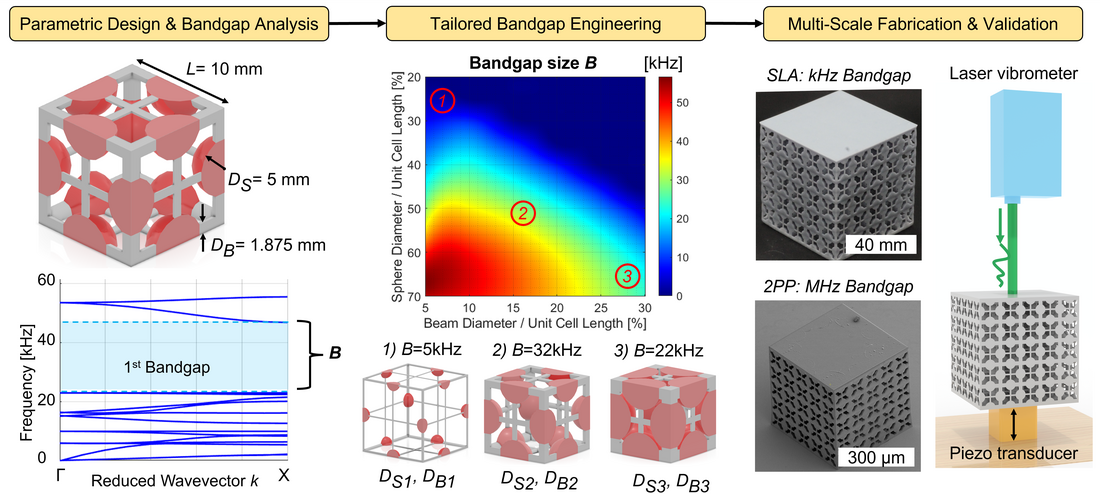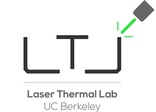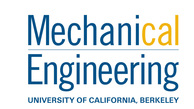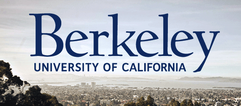Introduction
|
|
News
|
We are excited to share that our lab’s research was featured by Ansys! The Ansys case study showcases how we used PyAnsys and Python to automate the design and optimization of mechanical metamaterials. Led by PhD candidates Timon Meier and Runxuan Li, the work developed a fully automated workflow that explored vast design spaces and designed metamaterials that are simultaneously auxetic and isotropic, two rarely coexisting properties. Published in npj Computational Materials, our research highlights how high-throughput FEA simulations and optimization can accelerate the discovery and tailored design of architected materials.
Access the full Ansys write up here |
|
Thermovoltaic and solar thermal systems require emitters with high emissivity and durability at high temperatures. A femtosecond laser was used to machine light-trapping hierarchical micro/nanostuctures on metal surfaces, thereby achieving near blackbody emissivity over a wide spectral range while remaining stable at high temperatures. The fabricated emitted demonstrated doubling of therm-voltaic power without compromising efficiency. Minok Park, currently at Kongju National University in Korea is the first author of this study. The work was a collaboration of Vassilia Zorba's LBNL team with Asegun Henry of MIT, and Sean Lubner of Boston University. This work was published in Joule,
https://doi.org/10.1016/j.joule.2025.102005 |
|
PhD candidates Timon Meier and Vasileios Korakis present a scalable design framework for phononic metamaterials with ultra-wide, tunable bandgaps, achieving up to 172% normalized bandgap width. Inspired by the Yablonovite structure, their work leverages FEA simulations to create a parametric design space that links geometry to phononic behavior. The framework enables precise bandgap tailoring across scales, with designs fabricated at macro (10 mm) and micro (80 µm) levels using SLA and Two-Photon Polymerization. Experimental transmission loss measurements, closely match simulation predictions, validating the framework across multiple length scales. This study bridges theory and experiment, offering a practical and efficient path to custom-designed phononic metamaterials for vibration isolation, waveguiding, and ultrasonic applications. This work was published in Materials & Design: doi.org/10.1016/j.matdes.2025.113778
|
|
Laser-assisted atomic layer etching (ALEt) is a key technology enabling the minituarization of semiconductor devices. However, the mechanisms behind the laser−gas interactions and subsequent surface modifications remain elusive. PhD candidate Runxuan Li demonstrated ultraviolet picosecond laser-induced atomic layer etching of silicon in a gaseous chlorine environment, achieving selflimited etching with a precision of 0.93 nm/cycle. Through in situ optical emission spectroscopy, he elucidated the transition energy states of laser-excited products during chlorination. Simulation of transient adsorption of chlorine atoms reveals the complex spatiotemporal dynamics and surface saturation of laser-assisted ALEt processes. This work was published in The Journal of Physical Chemistry C, doi.org/10.1021/acs.jpcc.4c07330
|
|
Ultrafast near-field optical nanoscopy has emerged as a powerful platform to characterize various materials. While analytical and numerical models have been established to account for photoexcited carrier dynamics, quantitative evaluation of the associated pulsed laser heating remains largely unexplored. PhD candidate Rundi Yang, Runxuan Li, and postdoctral fellow Jingang Li demonstrated the decoupling of photocarrier density and temperature increase in near-field nanoscopy by integrating the two-temperature model (TTM) with finite-difference time-domain (FDTD) simulations. These results reveal that electron−phonon coupling in a silicon film cause up to a 14% variation in the near-field signal at a 220 μJ/cm2 pump pulse fluence. Experimental results are further validated by transient experiments, highlighting the potential of this method for investigations of carrier and thermal phenomena in emerging nanomaterials and nanodevices. This work was published in Nano Letters,
doi.org/10.1021/acs.nanolett.4c05419 |
|
PhD Candidate Brian Blankenship along with Post Doc Jingang Li demonstrate the utility of bubble printing to selectively pattern nanodiamonds onto a 2D plasmonic substrate. They create intricate patterns of nanodiamonds with micro-meter level feature sizes. Beyond patterning, they employ a lock-in widefield imaging method to map microscale 2D temperature profiles generated from laser heating. This work was published in Nano Letters,
https://doi.org/10.1021/acs.nanolett.4c02519 |
|
The self-organized coexistence of metallic and insulating phases in strained vanadium dioxide (VO2) has been previously observed, but the nanoscale visualization of these phase domains has remained challenging. PhD student Rundi Yang and postdoctoral fellow Jingang Li investigated the strain-modulated phases and carrier dynamics in VO2 nanobeams with the transient near-field nanoscopy. They demonstrated the nanoimaging of the alternating triangular-shaped phase domains on bent VO2 nanobeams, which have a feature size of approximately 200 nm. Through pump-probe s-SNOM measurements, they discovered that the metallic phase of VO2 exhibits slower carrier recombination and faster carrier diffusion compared to the insulating phase. These findings are crucial for the development of VO2-based sensing and microelectromechanical devices and further investigations into strongly correlated materials. This work was published in ACS Photonics, https://pubs.acs.org/doi/10.1021/acsphotonics.4c00848
|
|
PhD students Brian Blankenship and Timon Meier, have developed a non-destructive confocal microscopy technique to image internal defects in complex metamaterial structures with micro- and nanoscale architectures. Metamaterials often exhibit enhanced and unconventional properties compared to their bulk counterparts. By carefully incorporating defects into the microstructures of these materials, unique, and sometimes enhanced properties can be achieved. However, manufacturing defects can be problematic when their specific, uncontrolled incorporation is paramount to a material's functional properties. The team demonstrated the ability of confocal microscopy to non-destructively precisely locate and visualize a range of intentional incorporated defects inside of metamaterial lattices. This method not only enhances the existing array of diagnostic techniques but also opens the door for adapting and applying similar strategies during the fabrication process itself, enabling the in situ detection and characterization of defects. The work has been published in ACS Applied Engineering Materials, https://pubs.acs.org/doi/10.1021/acsaenm.4c00160
|
About
|
The Laser Thermal Lab is directed by Prof. Costas P Grigoropoulos of the Mechanical Engineering Department, UC Berkeley. Current research interests are focused on laser materials interactions, nanomanufacturing and the fundamental study of microscale and nanoscale transport phenomena.
Learn more about LTL |
Some Recent Publications
|
For a full list go to the Publications/Journals
|










